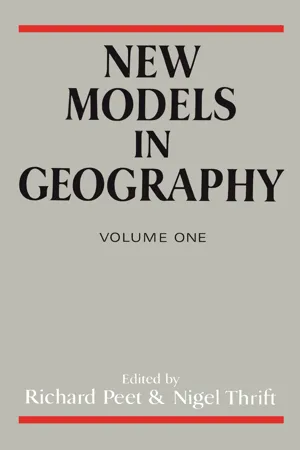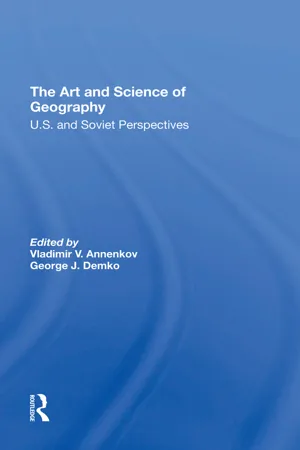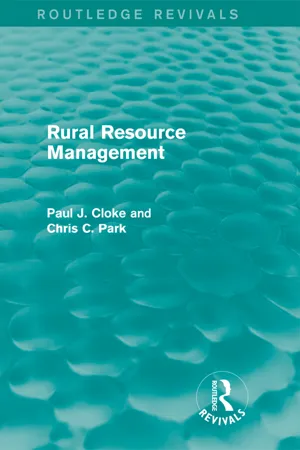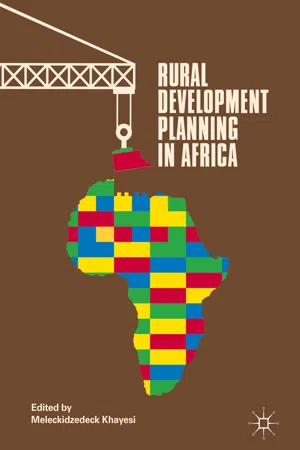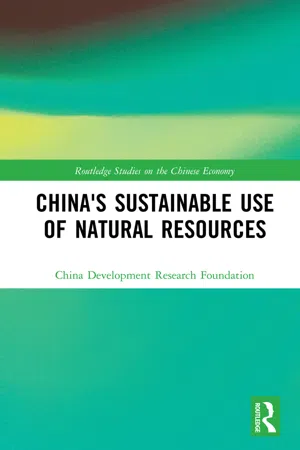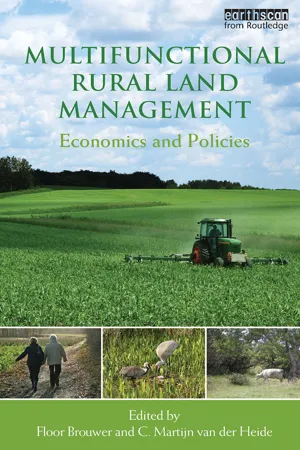Geography
Global Resource Management
Global Resource Management refers to the sustainable use and management of natural resources on a global scale. It involves the identification, allocation, and utilization of resources in a way that meets the needs of the present generation without compromising the ability of future generations to meet their own needs. This concept is crucial in ensuring the long-term survival of the planet and its inhabitants.
Written by Perlego with AI-assistance
Related key terms
Related key terms
1 of 4
Related key terms
1 of 3
6 Key excerpts on "Global Resource Management"
- eBook - ePub
- Richard Peet, Nigel Thrift(Authors)
- 2013(Publication Date)
- Routledge(Publisher)
These are both diffuse literatures, strewn over several academic disciplines and published in a broad array of journals and books. We focus on the contributions of geographers to this literature, particularly where their arguments depart from more dominant conceptualizations. In part we are imposing order where little existed. But, isn’t this the purpose of such a synthetic review?Resource management theoriesResource management research concentrates on the allocation and development of resources; the biophysical, technological, economic, social, political, and legal variables which account for patterns of allocation and development; the impacts of these patterns; and the decisions, controls, or policies that direct allocation and development (Mitchell 1979). The field is interdisciplinary and highly fragmented, in part a reflection of its strong empirical and policy-oriented emphasis. The term resource management is troublesome because of its technocratic and positivistic overtones, and because it is often narrowly interpreted to mean conscious, rational decision making.1 Typically, socialized knowledge, ideology, and contradictions in economic and political rationality have been neglected by the dominant resource management paradigms rooted in neoclassical economics and pluralistic political science. In addition, management implies practice but not necessarily theory or explanation. Although many argue that theory is a precondition of practice, this has not been a pre-eminent theme in resource geography (Wescoat 1987).Beginning with White’s (1945) floodplain analysis, resource geography has been an applied area of geography. In the tradition engendered by the Chicago resource/environmental School, in which White is the leading figure, resources, natural hazards, technological hazards, and wastes are examined with a view toward problem solving. The research question is ‘what can we do now to remedy this problem?' Confronting those taking neoclassical economic or engineering approaches to problem solving, resource geographers were able to broaden the discourse to include non-economic considerations (White 1961, 1969). This contribution, most apparent in floodplain development and river basin planning (Wescoat 1987), is no small feat given the hold that neoclassical economics and the engineering sciences continue to exercise on resource management. - eBook - ePub
The Art And Science Of Geography
U.s. And Soviet Perspectives
- Vladimir V. Annenkov, George J Demko(Authors)
- 2019(Publication Date)
- Routledge(Publisher)
Rodoman (USSR): If preventing war, world resource-economic crises, and the impoverishment of many developing countries can be considered global problems, then geography is closely related to the two latter issues and provides much concrete material for their understanding. What is needed is concrete knowledge of lands, rather than prognostic thinking. The classical geographer's erudition is capable of evaluating, reminding, and warning. The greater the hope for an agreement on arms limitation, the more threatening seems another hazard, an ecological crisis. And, ecology is now a field for all geographical sciences. It is said, however, that no civilization perished as a result of foreseeable events. This may console one and raise hopes that certain global problems are transient. On the other hand, it is frightening. Some decades ago it was impossible to foresee the AIDS pandemic or the outbreak, on an international scale, of Islamic fundamentalism. Is the source of future storms similarly unexpected? Does this mean that the sky over our heads will never be cloudless? Global problems require that people be broadly educated as never before, that they be capable of original thinking and of working easily with diverse material "ranging from geography to ideology." What other field of the humanities is more trained for this? I would place geography second after philosophy.What can geographers suggest for the preservation and more rational use of the natural resources of the earth?
Soviet and American geographers, addressing the question of more rational use of natural resources on the earth, agree that their research and views can be very useful and productive. They suggest that geography's man-environment research traditions, sensitivity to the interdependence of regional systems at all scales, and geographers' spatial data systems are invaluable inputs for resource study and planning at international levels. Soviet colleagues describe a number of specific research areas relating to energy and other resources for geographers.Brunn (USA): - eBook - ePub
- Paul Cloke, Chris C. Park, Paul Cloke, Chris C. Park(Authors)
- 2013(Publication Date)
- Routledge(Publisher)
Chapter Two RURAL RESOURCES This chapter aims to introduce the concept of resources and resource management, and to focus attention on the overall structure and dynamics of the rural resource system. 2.1 THE CONCEPT OF A RESOURCEDefinitive statements on terminology within resource management are extremely elusive because, as O’Riordan1 notes, there is no satisfactory definition of a resource , and no one definition has remained generally acceptable through time. This elusiveness arises partly because the very subject of ‘resources’ is inherently inter-disciplinary if not multi-disciplinary, and operational definitions vary between interested disciplines.Also important is the fact that a resource (in general terms) is not necessarily a tangible object, but it is a culturally-defined and abstract concept. In essence, anything can be regarded as a resource if it offers a means of attaining certain socially-valued goals. These goals can be extremely wide-ranging and they will vary through both space and time. Attainment of such goals is generally influenced by the prevailing social, political, economic and institution framework of the individual, group or unit responsible for the decision-making and so these elements all become important in any resource management system.Formulation of the ConceptThe foundations for much present-day thinking within resource management were laid down by Zimmermann2 . He viewed a resource in terms of a functional relationship between three things – human wants, human abilities, and human appraisal of the environment around him (using environment in its most general sense). The environment comprises both social/economic and physical/environmental elements and it offers a basic reservoir of what Zimmermann termed ‘neutral stuff - eBook - ePub
- Meleckidzedeck Khayesi, Meleckidzedeck Khayesi(Authors)
- 2017(Publication Date)
- Palgrave Macmillan(Publisher)
social and cultural functions. This chapter presents the evidence on natural resource management in Africa.Methods
Information for this chapter was collected through a review of literature related to natural resource management (NRM) with a focus on Africa. Two data sources were used. The first source is peer-reviewed journal papers, while the second one is grey literature, which includes working papers, theses, meetings, organizational and project reports as well as case studies. The bibliographic databases searched included Web of Science, Scopus, IDRC library, UCT library, Google Scholar and Google search engine. The search was conducted in two stages. Stage one involved searching for literature on natural resource management in Africa. A keyword search was performed within the ISI Web of Knowledge electronic database using the keywords (in all fields): ‘natural resource management’ AND ‘Africa’. Stage two involved searching for literature relevant to best practices in natural resources management in Africa. These two stages yielded 115 publications. Applying the inclusion and exclusion criteria summarized in Table 2.1 , yielded 12 articles for final review (Table 2.2 ).Table 2.1 Criteria for inclusion or exclusion of articles during systematic review processCriteria Excluded Included Justification Date of publication Articles published prior to 1980 Articles published between January 1980 and December 2015 It is assumed that attention on NRM in Africa, particularly community-based natural resource management started gaining momentum in 1980Language of publications Articles published in languages other than English Articles published in English To facilitate understanding of published articles Main theme of publication Articles that did not pay particular attention to NRM in Africa Articles that had the words NRM in Africa in title or abstract The chapter focuses on natural resource management in Africa Availability of article Articles that were not available on the Web of Science Articles that are available in the Web of Science The Web of Science provides an authoritative source for filtering literature from published sources Country or region of study - eBook - ePub
- China Development Research Foundation(Author)
- 2020(Publication Date)
- Routledge(Publisher)
Meanwhile, as more participants join in global resource governance and as levels of activity increase, new resources and energy will be brought to the process but complexities and difficulties will also increase. The conventional resource governance systems could be divided into two parts, domestic and international. As globalization has deepened, however, resource-related interests have increasingly formed alliances across borders in the areas of international trade and investment, as well as alliances within a country. In the past, governance at the global level was primarily a matter for governments. In the future, however, multinational corporations, nongovernmental organizations, and even individuals will participate in large numbers in global governance and will play an important role. This means that traditional rules and regulations regarding resource governance will be confronting new challenges. The unequal allocation of benefits among different countries and within a country poses problems when it comes to forming a stable and consistent resource-allocation system. In the past 20 years or more, the income disparity between developing and developed countries has been widening. Social fairness and the sustainability of resources and the environment are closely connected. If a country’s economic and social situation is inequitable, that influences resource rights and interests and environmental pollution and vice versa. It triggers conflict and turns confrontation into a constant state of affairs. Consensus dissolves, which can lead to political confrontation and even to unstable governments. It can shake the foundations of global resource governance. Unequal allocation of resources between and among countries stirs up antagonisms and makes coordinated action on an international scale much more difficult.At the present time, the global resource governance system still suffers from a lack of cohesion and integration. It is characterized by too many administrative levels, too much complexity, and a loose and fragmented approach. The world’s countries have already formed a variety of platforms and mechanisms that relate to resources, including energy, water, forests, oceans, and climate change. The systems of rules and regulations that these platforms and mechanisms depend on all have different emphases but are mutually related. In addition to governmental platforms, multinational corporations and industry organizations also have coordinating mechanisms that have to do with resource governance and they also have formed governance mechanisms with the government bodies, corporations, social organizations, and consumers within a given country. All these multitudinous entities have varying administrative levels with various kinds of status. They influence one another and together make up the highly complex global resource governance system. - eBook - ePub
Multifunctional Rural Land Management
Economics and Policies
- Floor Brouwer, C. Martijn van der Heide, Floor Brouwer, C. Martijn van der Heide(Authors)
- 2012(Publication Date)
- Routledge(Publisher)
1
Natural Resource Management:Globalization and RegionalIntegration
Floor Brouwer and C. Martijn van der Heide
Introduction
Management of rural land currently attracts a considerable and almost obsessive popular interest, and dominates both the scientific and policy agendas. In the first half of 2008, many newspapers carried alarming headlines using pejorative terms, such as ‘skyrocketing food prices’, ‘world hunger’, ‘pasta strikes’ and ‘food insecurity’. All of these ‘threats’ are but one side of the coin whose other side bears the stamp of changing rural land use. And this change in land use, as we could read in the media, has occurred for various reasons, including the demand for biofuels, the growing populations in China and India that have developed Western tastes as their economies grow, climate change resulting in high temperatures and severe drought with loss of harvest in some major productive regions.The intense and agitated attention on rural land use changes and the worldwide threats they entail evoked heated and sometimes emotional reactions. High food prices, for example, heated up the debate about the conversion of agricultural land into nature areas and fuelled concerns about agricultural land being used to produce biofuels. The issue of soaring food prices and the satisfaction of the world's seemingly insatiable appetite is, however, just one example of the challenges that rural areas are facing. In fact, due to the multiple functions of rural areas (to which we shall return hereafter) and the various actors – such as farmers, nature conservationists, tourists and inhabitants – involved, collisions between human demands and the capacity of rural areas to satisfy them are becoming daily events. These collisions are further complicated by the fact that land use in rural areas is characterized by a multifaceted interaction between ecological processes and socio-economic activities. The development of many rural areas has resulted in environmental degradation, and from an anthropocentric perspective, less productive, but more fragile ecosystems. Food production, for example, is affected, and is already being constrained by processes of soil degradation, water shortages and the effects of climate change.
Index pages curate the most relevant extracts from our library of academic textbooks. They’ve been created using an in-house natural language model (NLM), each adding context and meaning to key research topics.
Explore more topic indexes
Explore more topic indexes
1 of 6
Explore more topic indexes
1 of 4
